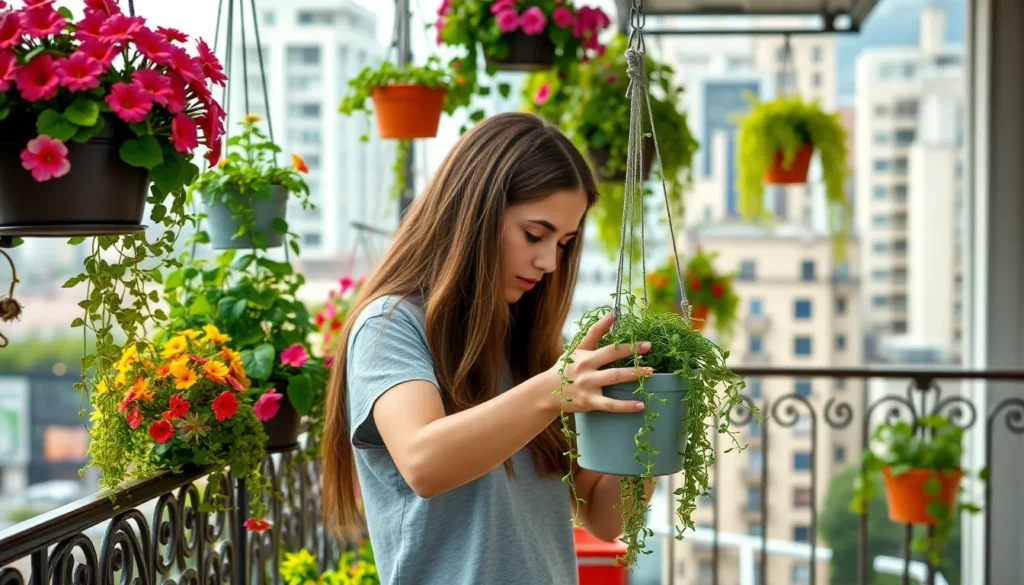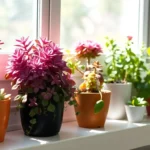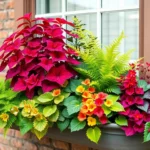Transforming your balcony into a lush green sanctuary doesn’t require a massive budget or extensive gardening experience. Balcony hanging plants on railings offer the perfect solution for urban dwellers who crave nature’s beauty in limited spaces. We’ve discovered that these vertical gardens not only maximize your growing area but also create stunning visual displays that’ll make your neighbors envious.
Whether you’re dealing with a tiny apartment balcony or a spacious outdoor deck, hanging plants on railings can dramatically change your space’s atmosphere. From cascading flowers to trailing herbs, these suspended gardens bring life and color to otherwise unused vertical space. The best part? You don’t need to sacrifice floor space for planters.
We’ll show you how to select the right plants, choose appropriate containers, and install secure hanging systems that’ll keep your green friends thriving. Get ready to transform your balcony railing into a breathtaking garden paradise that delivers maximum impact with minimal effort.
Choose the Right Hanging Planters for Your Balcony Railings
Selecting appropriate planters ensures your hanging garden thrives while maintaining safety and aesthetic appeal. We’ll guide you through the essential factors that determine planter success for railing installations.
Weight Capacity Considerations
Check your railing’s load bearing limits before selecting any hanging planters. Most standard apartment balcony railings support 15-20 pounds per linear foot, while reinforced railings handle up to 50 pounds. Lightweight materials like plastic and fiberglass work best for older or weaker railing systems.
Distribute weight evenly across multiple attachment points to prevent structural damage. We recommend spacing planters at least 3 feet apart on standard railings. Terra cotta and ceramic planters typically weigh 2-5 pounds empty, adding 8-12 pounds when filled with soil and plants.
Consider the total weight including soil, plants, and water retention. Wet soil weighs approximately 75 pounds per cubic foot, making a 12-inch planter weigh up to 15 pounds when fully saturated. Calculate your total load by multiplying planter volume by soil weight plus container weight.
Material Durability and Weather Resistance
Choose materials that withstand your local climate conditions year round. Resin and high density polyethylene planters resist cracking in temperatures from -20°F to 120°F. Metal planters require powder coating or galvanized finishes to prevent rust and corrosion.
Avoid materials that deteriorate quickly under UV exposure and moisture cycles. Standard plastic planters fade and crack within 2-3 seasons of direct sunlight exposure. Fiberglass reinforced planters maintain color and structural integrity for 8-10 years with minimal maintenance.
Select planters with UV stabilizers and fade resistant properties for long term performance. We’ve found that planters labeled “UV resistant” typically last 3-5 times longer than basic versions. Natural materials like untreated wood require annual sealing to prevent rot and insect damage.
Size and Drainage Requirements
Match planter dimensions to your chosen plants’ root system needs and mature size. Trailing plants like petunias require 6-8 inch deep containers, while herbs need 10-12 inches for proper root development. Small flowering plants thrive in planters 8-10 inches wide and deep.
Ensure adequate drainage holes prevent waterlogged soil and root rot issues. We recommend at least 4-6 drainage holes per 12-inch planter bottom. Drill additional holes if your chosen planters lack sufficient drainage options.
Consider planter depth for different plant types and growth patterns. Shallow rooted plants like lettuce and strawberries need 6-8 inches of soil depth. Deep rooted vegetables and larger flowering plants require 12-14 inches for healthy growth and development.
Select Plants That Thrive in Hanging Balcony Conditions
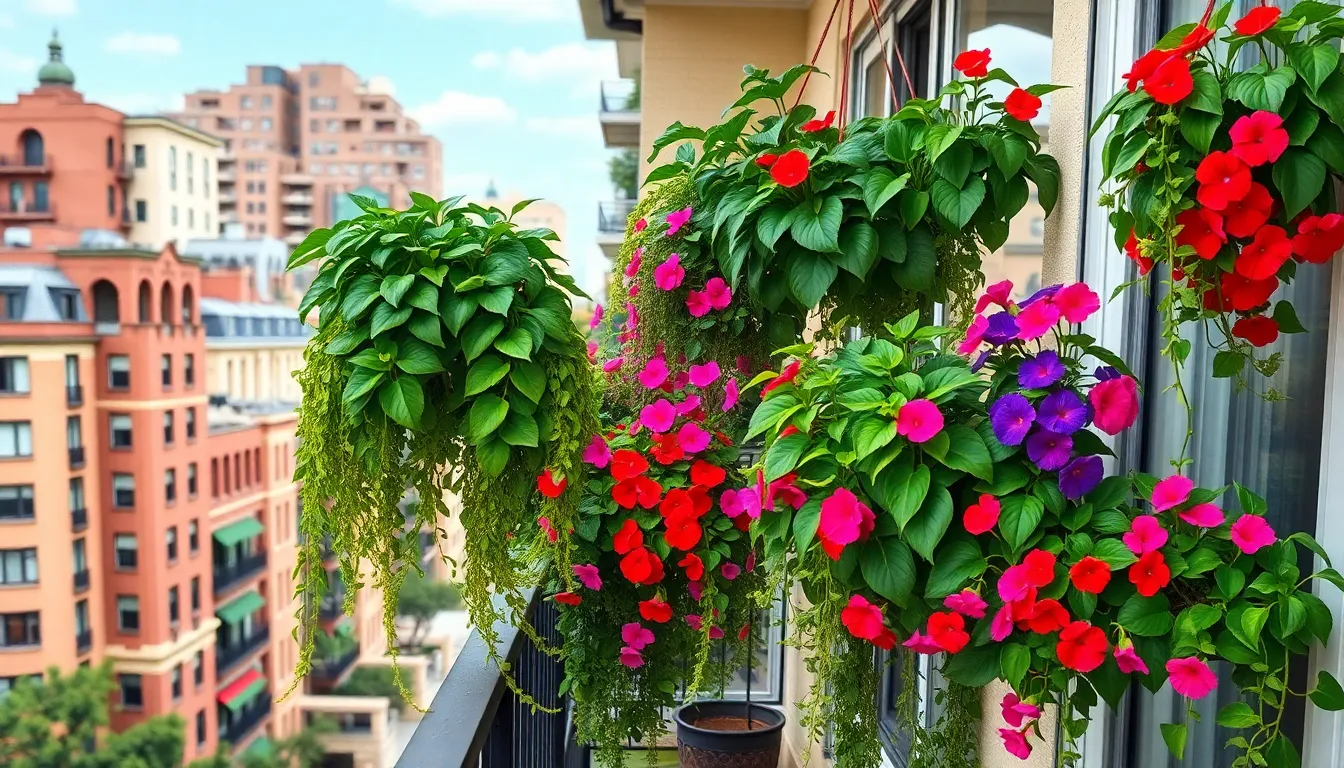
Now that we’ve covered the essential planter considerations, we need to focus on choosing plants that’ll flourish in your balcony’s exact conditions.
Trailing and Cascading Varieties
String of Bananas leads our list of top trailing plants for balcony railings. This succulent creates stunning cascading vines with distinctive banana-shaped leaves that form a lush green curtain effect. We love how it requires bright, indirect sunlight while remaining drought-tolerant and low maintenance. During winter months, it’ll reward you with delicate white flowers that add seasonal interest to your vertical garden.
Petunias bring vibrant color to sunny balcony spaces throughout the growing season. These flowering champions thrive in full sun conditions and bloom abundantly from spring through fall. Their low maintenance requirements make them perfect for busy gardeners who want maximum visual impact with minimal effort.
Begonias excel in shaded or semi-shaded balcony environments where other flowering plants struggle. We recommend these attractive bloomers for north-facing balconies or spaces with limited direct sunlight. Their colorful flowers and lush foliage create beautiful cascading displays even in challenging light conditions.
Trailing rosemary, jasmines, and sweet peas offer fragrant additions to full sun balconies. These aromatic plants combine beautiful trailing growth habits with delightful scents that enhance your outdoor experience. We particularly appreciate how they serve dual purposes as decorative elements and aromatic herbs.
Oregano provides both culinary value and visual appeal in hanging displays. This trailing herb produces small summer flowers while offering drought tolerance and moderate temperature preferences. Regular pruning enhances its bushy growth pattern and intensifies its fragrance, plus it naturally repels pests from your balcony garden.
Sun and Shade Tolerance Assessment
Full sun plants require six or more hours of direct sunlight daily. Petunias, trailing rosemary, jasmines, sweet peas, and moss phlox all flourish in these bright conditions. We recommend positioning these sun-loving varieties on south-facing railings or areas with maximum light exposure.
Shade tolerant options work best in areas receiving less than four hours of direct sunlight. Begonias and small-leaved ivy adapt well to these lower light conditions on north-facing balconies. These plants maintain their beauty and growth even when direct sunlight is limited throughout the day.
Partial shade adaptable varieties offer flexibility for balconies with changing light patterns. Many plants can adjust to semi-shade conditions when they receive four to six hours of sunlight daily. We suggest observing your balcony’s exact sun exposure patterns throughout different seasons before making final plant selections.
Maintenance and Growth Requirements
Well-draining soil prevents root rot and ensures healthy plant development. Succulents like String of Bananas particularly need excellent drainage to thrive in hanging containers. We recommend using potting mixes specifically formulated for container gardening rather than garden soil.
Watering schedules vary significantly between plant types and seasons. Drought-tolerant succulents need less frequent watering, while flowering plants like petunias benefit from consistent moisture levels. We suggest checking soil moisture regularly rather than following rigid watering calendars.
Pruning and deadheading encourage bushier growth and extended flowering periods. Oregano benefits from frequent trimming to promote leaf growth and enhance fragrance production. Regular maintenance keeps your hanging plants looking their best throughout the growing season.
| Plant Type | Nutrient Requirements | Pruning Frequency | Wind Resistance |
|---|---|---|---|
| String of Bananas | Low | Minimal | High |
| Petunias | Moderate | Weekly deadheading | Moderate |
| Begonias | Moderate | Bi-weekly | Low |
| Oregano | Low | Weekly | High |
| Moss Phlox | Low | Seasonal | High |
Wind resistance becomes crucial for railing-mounted plants exposed to elevated air currents. Trailing plants that bind well and develop strong root systems help prevent wind damage to both plants and containers. We recommend securing lightweight containers and choosing plants with flexible stems that bend rather than break in windy conditions.
Install Secure Mounting Systems for Safety
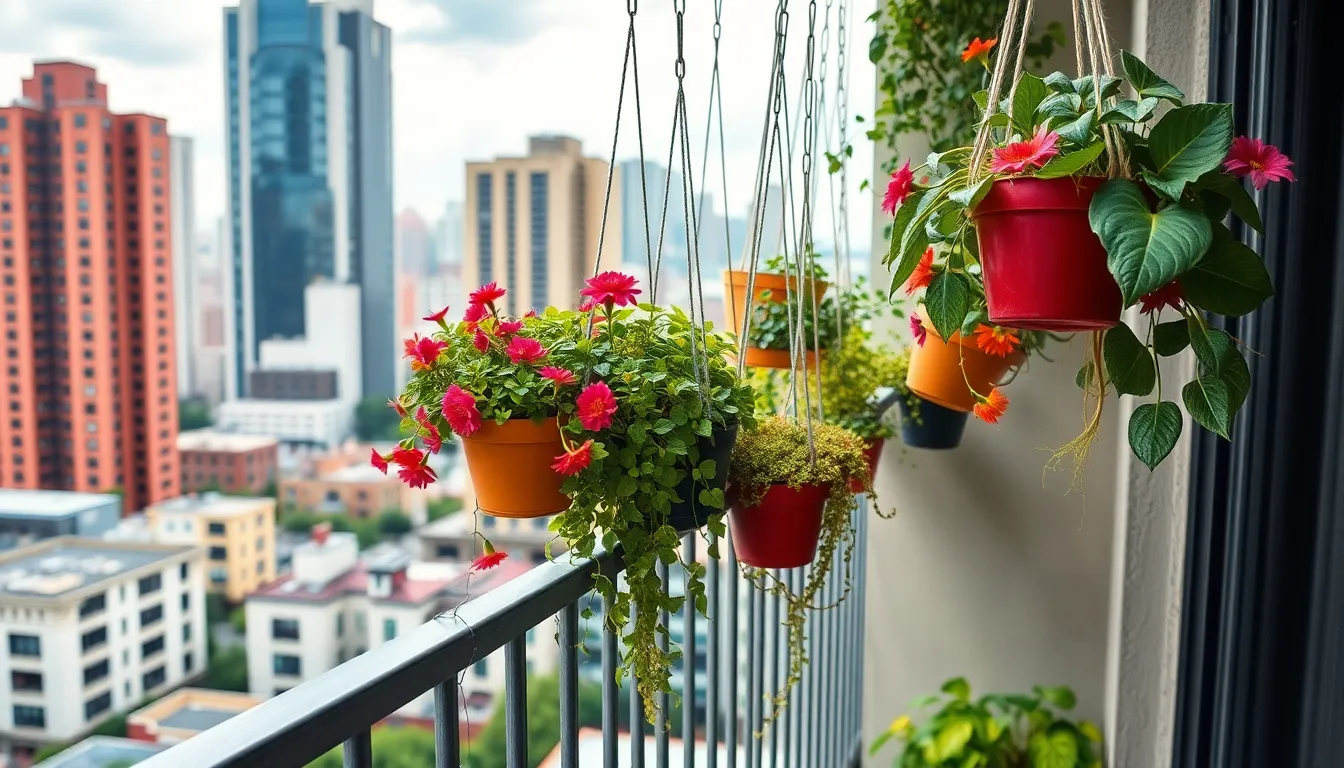
Securing your hanging plants properly protects both your investment and anyone below your balcony. We’ll explore three proven mounting methods that ensure your balcony garden stays safely in place.
Railing Clamp Attachments
Clamp-style plant hangers wrap around the top or side of your railing using tension to stay firmly in place. These attachments work best on metal or wood railings and feature adjustable sizing for different railing dimensions. We recommend choosing clamps specifically designed to grip balcony railings firmly without causing damage to the surface.
Installation becomes straightforward since these systems avoid drilling holes entirely. You’ll preserve your railing’s integrity while creating a renter-friendly solution that won’t affect your security deposit. Adjustable hooks on these railing hanging racks provide secure points to hang pots or shelves, allowing for easy repositioning and removal of plants without impacting the structure.
Over-the-Rail Hanging Answers
Over-the-rail hangers hook directly over your balcony rail and hold plants using gravity and friction. These answers often combine with S-hooks to help easy plant removal and replacement throughout the growing season. We favor this method for renters or anyone wishing to avoid damage to railings or walls.
Simply hook the hanger over your rail and adjust the position as needed. The design distributes weight naturally while providing stable support for your hanging plants. These systems work particularly well when you need to move plants frequently for maintenance or seasonal changes.
Weight Distribution Techniques
Distribute plant weight evenly along your railing to avoid excess stress on any single point. Using multi-tiered racks or multiple hooks helps spread the load across a wider area of your railing system. We ensure railing posts and brackets stay properly anchored to the building frame to withstand the additional lateral pressure from hanging plants.
Avoid cluttering railings with heavy planters positioned close together, as this can compromise railing stability and create safety hazards. Regular inspection of your railing’s attachment points and the plants’ hanging systems maintains structural integrity over time. Space your hanging plants at least 18 inches apart to prevent overloading any section of your balcony railing.
Position Plants for Optimal Growth and Aesthetics
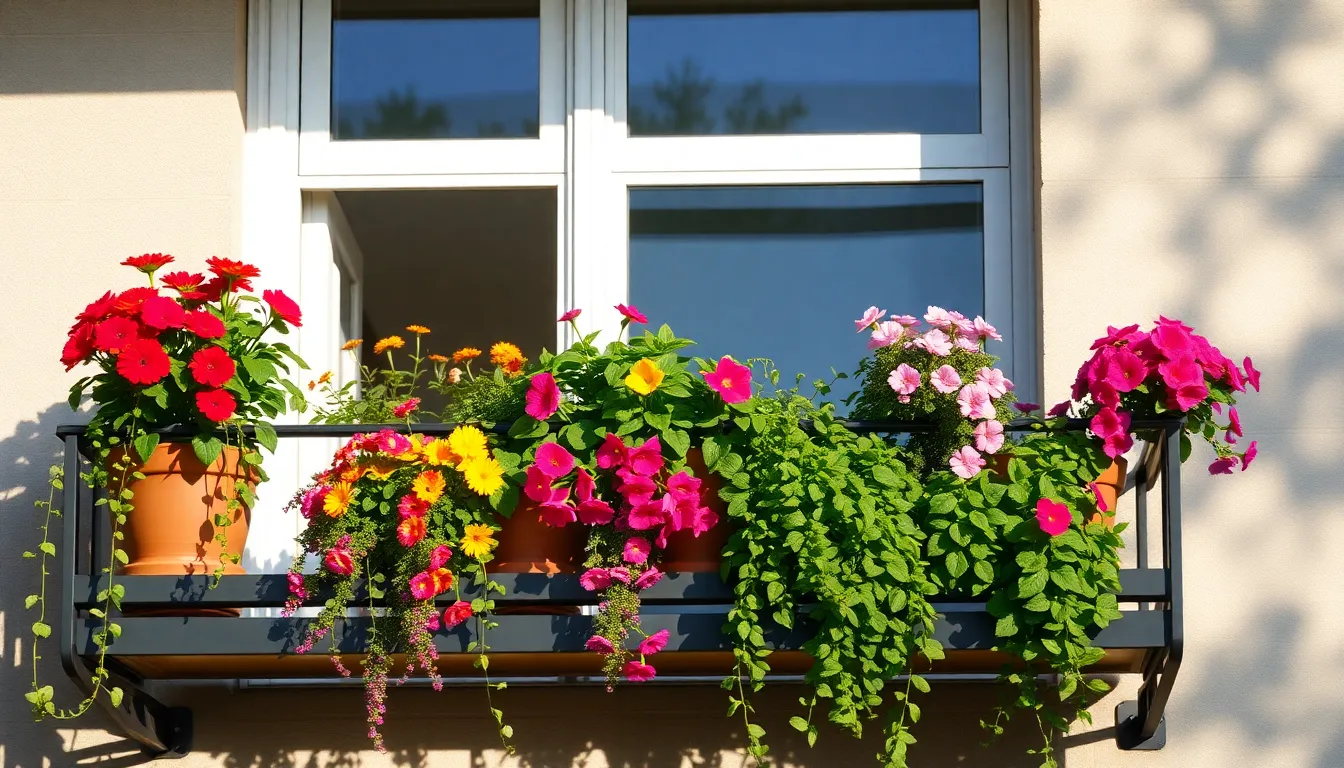
Strategic plant positioning transforms your railing setup from a simple display into a thriving network that maximizes both beauty and plant health.
Light Exposure Considerations
Assess your balcony’s natural light patterns before selecting plant locations. South-facing balconies receive ample sunlight throughout the day, making them perfect for sun-loving varieties like petunias and marigolds. North-facing or heavily shaded areas work better for shade-tolerant species such as begonias and impatiens.
Monitor light changes throughout different seasons since surrounding buildings or trees can alter exposure patterns. We recommend observing your space for at least a week to understand how shadows move across your railing. East-facing balconies get gentle morning sun but afternoon shade, while west-facing ones experience intense afternoon heat.
Match each plant’s exact light requirements to its designated spot along your railing. Full-sun plants need 6-8 hours of direct sunlight daily, while partial-shade varieties thrive with 3-6 hours. Shade-tolerant plants can flourish with filtered light or indirect exposure.
Visual Balance and Spacing
Space your railing planters evenly to prevent overcrowding and ensure proper airflow between plants. We suggest maintaining at least 18 inches between mounting points to avoid overwhelming your railing’s structure while allowing each plant adequate growing room.
Combine plants of varying heights and textures to create ever-changing visual interest along your balcony perimeter. Trailing varieties like Creeping Jenny work beautifully along outer edges, while upright plants such as small shrubs or compact vegetables create central focal points.
Use rectangular or long box planters to establish continuous green displays that flow seamlessly across your railing length. Layer different plant types by placing taller specimens toward the back and cascading varieties in front for depth and dimension.
Incorporate trellises or support structures for climbing plants to maximize your vertical growing space. This technique adds height variation while training vines upward rather than allowing them to compete for horizontal space.
Accessibility for Maintenance
Install plants within easy reach for regular watering, pruning, and harvesting tasks. We position frequently maintained plants like herbs and vegetables closest to balcony doors or high-traffic areas for convenient daily care.
Secure planters with stable fasteners or hooks that allow easy removal when deep cleaning or seasonal plant changes become necessary. Choose mounting systems that don’t require tools for basic adjustments or temporary relocation during severe weather.
Select lightweight, weather-resistant materials that won’t become unmanageable when soil is saturated after watering or rain. Plastic composites and aluminum planters offer durability without excessive weight that complicates handling during maintenance routines.
Plan clear pathways along your balcony floor so you can safely access all railing-mounted plants without stepping over obstacles or reaching awkwardly across barriers.
Maintain Your Hanging Balcony Garden Successfully
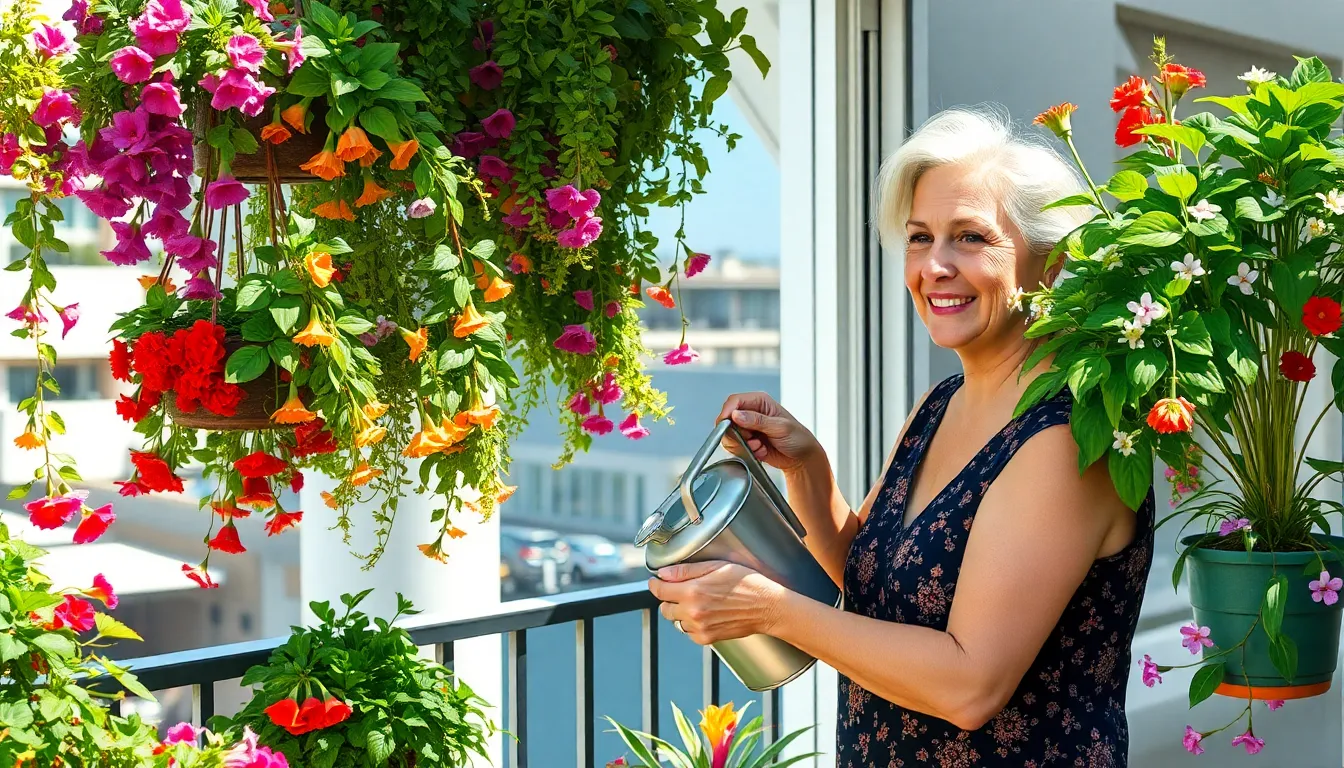
We’ve got our plants positioned and mounted—now let’s keep them thriving year-round. Consistent care routines ensure your hanging garden remains vibrant and healthy throughout every season.
Watering Schedules and Techniques
Water your hanging plants during the coolest parts of the day, ideally early morning or late evening, to prevent rapid evaporation. Early morning watering gives plants time to absorb moisture before the heat builds up.
Check soil moisture frequently since smaller hanging baskets dry out faster than ground-level containers. Poke your finger about an inch into the soil—if it feels dry, it’s time to water.
Apply water thoroughly until it drains from the bottom holes, ensuring the soil becomes evenly moist throughout. Avoid waterlogging, which can cause destructive root rot in your hanging plants.
Skip planters with coconut coir liners when mounting on railings since they dry out too quickly and require more frequent watering sessions.
Fertilizing and Pruning Guidelines
Fertilize regularly during the growing season when soil feels moist rather than when plants appear wilted. Always follow the exact instructions on your fertilizer package for best results.
Apply slow-release fertilizers in spring to provide sustained nutrient supply throughout the growing months. These fertilizers reduce the frequency of feeding sessions while maintaining consistent plant nutrition.
Prune your hanging plants once or twice per season to remove straggly growth and maintain attractive shapes. Trimming promotes fuller, healthier plants and encourages new branching.
Cut back about two inches or more for trailing flowers to stimulate fresh growth and continued blooming throughout the season.
Seasonal Care Adjustments
Adjust watering frequency with changing seasons since plants typically require more water during warmer months and less during cooler periods. Monitor your plants closely as temperatures fluctuate.
Protect plants from direct harsh sunlight which can burn delicate leaves and stress your hanging garden. Most hanging plants prefer bright, indirect light for optimal growth.
Repot plants when roots begin bulging at the drainage holes to maintain healthy growth space. Root-bound plants struggle to absorb nutrients and water effectively.
Choose shade-tolerant plants like pothos or spider plants for balconies with limited natural light to ensure year-round greenery and consistent growth.
Design Creative Arrangements for Maximum Impact
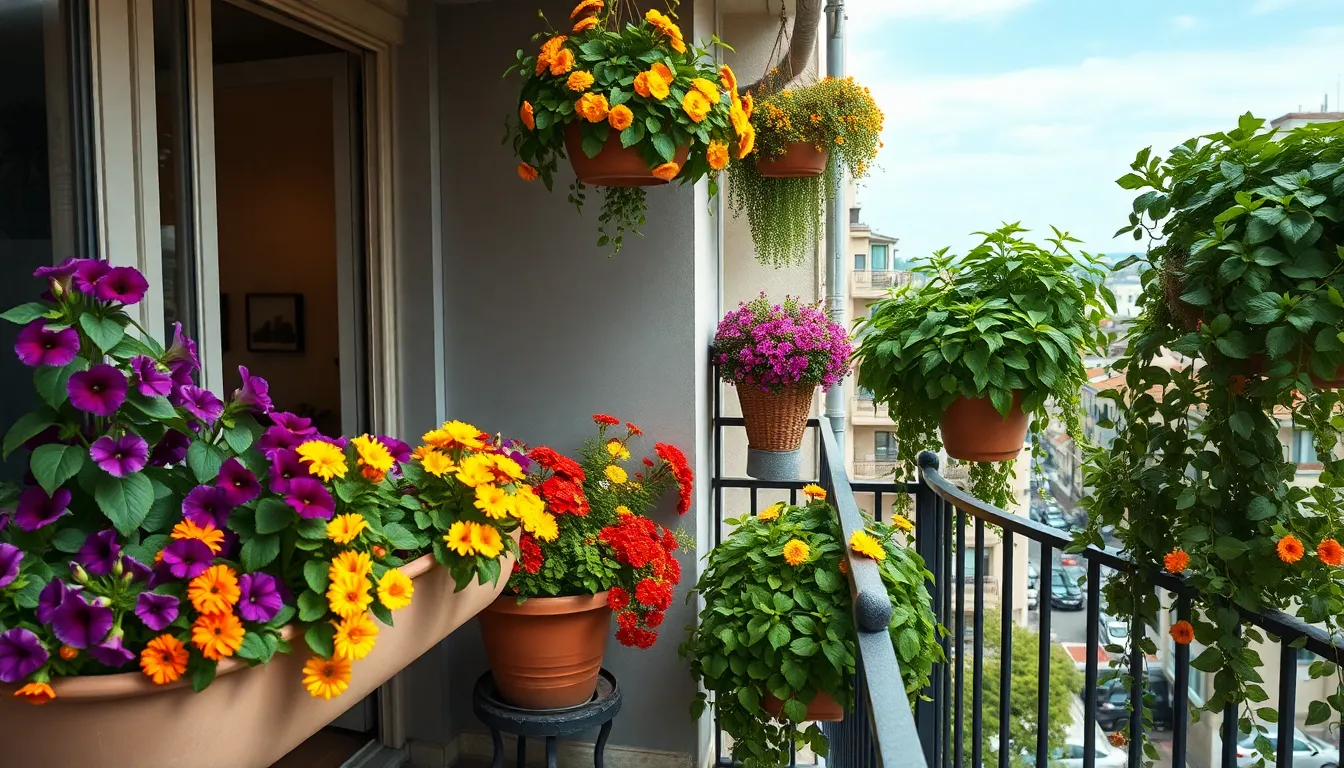
Creating stunning visual displays with your railing-mounted garden requires thoughtful arrangement and strategic plant selection. We’ll explore how to transform your balcony railing into a captivating green showcase through careful design choices.
Color Coordination and Plant Combinations
Complementary color schemes work best when pairing flowering plants with contrasting blooms. We recommend combining purple petunias with yellow marigolds or orange geraniums with white sweet alyssum for vibrant displays that catch the eye from any angle.
Foliage variety adds texture and depth beyond just flower colors. Popular balcony railing plants like ivy provide rich green backdrops while succulents offer unique shapes and silvery tones that complement traditional flowering varieties.
Year-round appeal comes from mixing plants with different bloom times alongside evergreen options. We suggest pairing spring-blooming bulbs with summer annuals and adding ornamental grasses that maintain structure through fall and winter months.
Sensory combinations enhance the balcony experience when you blend fragrant herbs like lavender or rosemary with visually striking flowering plants. This approach creates environments that engage multiple senses while maximizing the limited railing space available.
Vertical Space Utilization
Over-the-railing planters maximize space efficiency by straddling standard 2″x4″ or 2″x6″ railings without requiring additional mounting hardware. These straddle-style containers secure easily and allow you to plant along the entire railing length without damaging the structure.
Multiple tiers create dramatic height variations when you arrange planters at different levels along the same railing section. We recommend using wall-mounted brackets above the railing combined with hanging baskets below to establish vertical layers that don’t sacrifice floor space.
Continuous borders form when you hang several planters in rows along extended railing sections. This technique works particularly well for creating privacy screens or defining outdoor living areas while maintaining easy access for maintenance tasks.
Clustering techniques involve grouping different sized planters together at strategic points rather than spacing them evenly. We find that arranging three to five containers of varying heights creates focal points that draw attention and add visual weight to key areas of your balcony.
Seasonal Rotation Strategies
Spring and summer rotations focus on heat-loving annuals that thrive in warmer temperatures and longer daylight hours. We plant petunias and geraniums during these seasons because they provide continuous blooms and handle the increased sun exposure common in elevated balcony locations.
Fall and winter transitions require switching to hardy plants that tolerate temperature drops and reduced sunlight. Ornamental cabbages and cold-hardy herbs maintain visual interest while withstanding cooler weather conditions that would damage summer flowering varieties.
Quick-growing options like salad greens and herbs provide short-term seasonal interest while offering practical benefits. These plants establish rapidly and can be harvested regularly, making them ideal for gardeners who want both beauty and utility from their railing gardens.
Lightweight rotation systems simplify seasonal changes when you choose removable planters that lift off easily without tools. This approach allows you to swap entire containers rather than replanting individual specimens, reducing the time and effort required for seasonal garden updates.
Avoid Common Mistakes When Hanging Plants on Railings
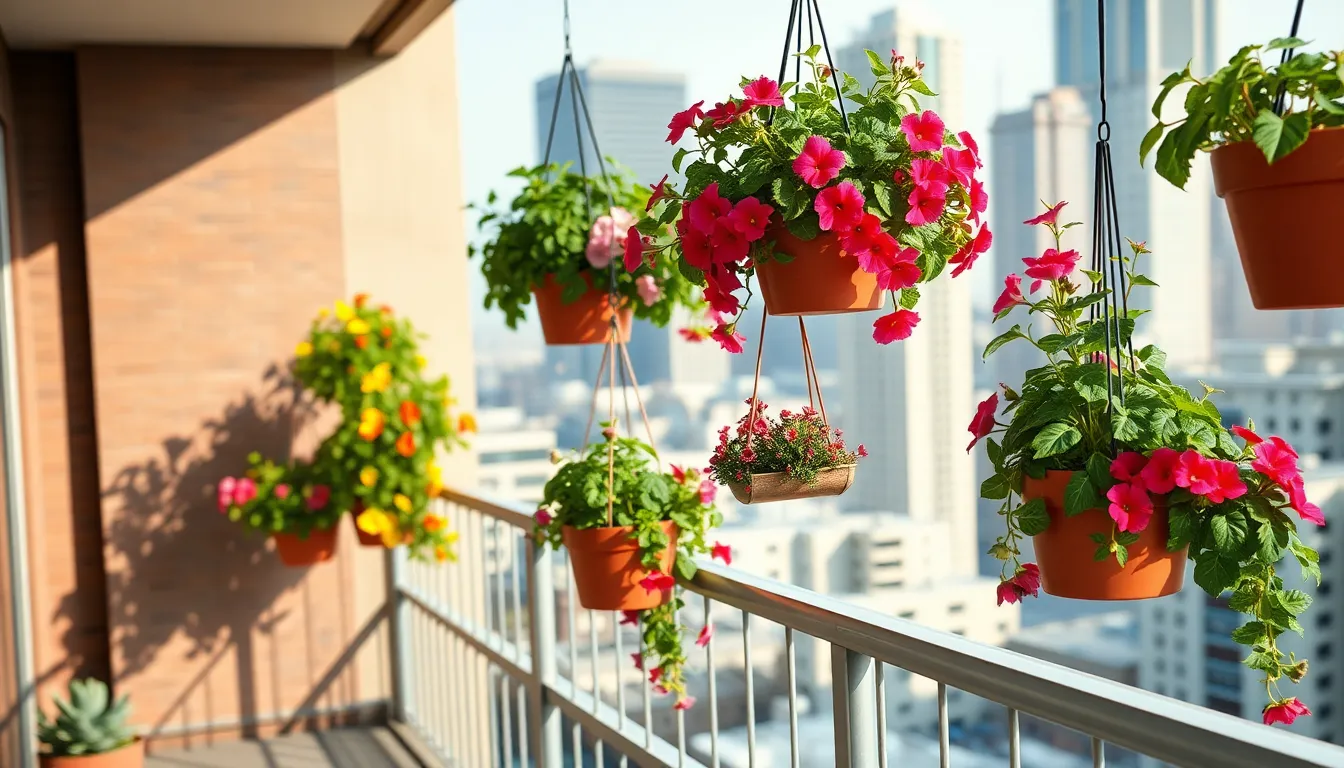
Even experienced gardeners can make costly errors when setting up their balcony hanging gardens. We’ll help you avoid the most common pitfalls that could compromise your plants’ health and your balcony’s safety.
Overloading Weight Limits
Exceeding your railing’s weight capacity poses serious safety risks and can damage your balcony structure. Balcony railings have exact weight limits that should never be exceeded to prevent accidents or structural damage. We recommend checking your railing’s load bearing specifications before adding multiple planters.
Choose lightweight planters designed to distribute weight effectively across the railing system. Materials like fiberglass, plastic, or aluminum provide excellent durability without adding excessive weight. Metal planters filled with soil and water can quickly exceed safe weight limits, especially when multiple containers are installed on the same railing section.
Distribute your hanging planters across multiple attachment points rather than clustering them in one area. This approach prevents stress concentration on any single railing segment. We suggest spacing planters at least 18 inches apart to maintain structural integrity and allow adequate air circulation between plants.
Ignoring Wind Exposure
Balconies experience significantly stronger wind currents than ground level gardens, making secure attachment crucial. Wind exposure can topple unsecured planters, damage plants, and create safety hazards for people below. We recommend selecting sturdy planters with secure attachment mechanisms that won’t loosen over time.
Use straps or locking mechanisms on brackets to keep planters firmly in place during windy conditions. Specialized deck rail box brackets with adjustable straps and locks ensure a safe and secure fit, especially for irregular or metal railings. These systems prevent planters from shifting or falling during storms.
Select wind resistant plants with flexible stems that can bend without breaking in strong gusts. Plants like petunias, trailing lobelia, and ivy geraniums adapt well to windy balcony conditions. We avoid top heavy plants or those with brittle stems that snap easily in elevated air currents.
Inadequate Drainage Planning
Proper drainage prevents waterlogged soil, root rot, and water damage to your balcony surface. Poor drainage creates standing water that kills plant roots and can stain or damage balcony flooring. We always use planters with adequate drainage holes sized appropriately for the container volume.
Install drip trays or saucers underneath planters to catch excess water and protect your balcony. Consider how drainage water flows to ensure it doesn’t spill onto neighbors below or create slippery surfaces. We position catch trays slightly larger than the planter base to capture all runoff effectively.
Choose planter depths of 6 to 8 inches for most flowers and herbs, with 10 inches or more for vegetables. Deeper containers require more drainage holes to prevent water accumulation at the bottom. We ensure drainage holes are positioned at the lowest point of angled or curved planter bottoms for optimal water flow.
Conclusion
Creating a stunning hanging garden on your balcony railings doesn’t have to be complicated. With the right planters proper mounting systems and careful plant selection we’ve shown you how to transform any balcony into a thriving green oasis.
Remember that success comes from balancing safety with beauty. Always check your railing’s weight capacity choose appropriate drainage answers and select plants that match your exact light and maintenance preferences.
Your balcony hanging garden will reward you with fresh air improved aesthetics and the satisfaction of growing your own green sanctuary. Start small experiment with different arrangements and watch as your vertical garden becomes the highlight of your outdoor space.
Frequently Asked Questions
What are the best plants for hanging on balcony railings?
The best plants for balcony railings include trailing varieties like String of Bananas, petunias, and begonias. Choose plants based on your balcony’s light conditions – full sun options like petunias for sunny spots, or shade-tolerant varieties like begonias for less sunny areas. Wind-resistant plants with flexible stems work best for elevated positions.
How much weight can balcony railings support for hanging plants?
Weight capacity varies by railing type and construction. Always check your railing’s specifications before adding plants. Distribute weight evenly across multiple attachment points rather than concentrating it in one spot. Use lightweight planters and avoid overloading any single section to maintain structural integrity and safety.
What type of containers work best for railing-mounted plants?
Choose lightweight, weather-resistant containers with proper drainage holes. Materials like resin, fiberglass, or lightweight ceramic work well. Ensure containers match your plant’s root system size and include drainage solutions to prevent waterlogged soil. Consider wind resistance when selecting container shapes and weights.
How do I securely attach hanging planters to railings?
Use proven mounting methods like clamp-style attachments that wrap around railings, over-the-rail hangers that use gravity and friction, or multi-tiered racks for weight distribution. Space plants at least 18 inches apart and ensure all attachments are sturdy enough to withstand wind and weather conditions.
How often should I water hanging plants on my balcony?
Water during cooler parts of the day to prevent evaporation. Check soil moisture frequently as smaller hanging containers dry out faster than ground planters. Adjust watering frequency based on weather conditions, plant types, and seasonal changes. Avoid overwatering by ensuring proper drainage in all containers.
What mistakes should I avoid when hanging plants on railings?
Avoid overloading weight limits, using inadequate drainage, and choosing plants unsuitable for your light conditions. Don’t neglect wind resistance considerations or fail to secure planters properly. Avoid clustering too many plants in one area and ensure regular maintenance access when positioning your hanging garden.
How do I create an attractive arrangement with hanging plants?
Use complementary color schemes and vary plant heights and textures for visual interest. Mix plants with different bloom times and include evergreen options for year-round appeal. Create continuous borders or cluster arrangements, and consider seasonal rotation strategies to maintain fresh, captivating displays throughout the year.
Can I grow hanging plants on my balcony year-round?
Yes, with proper plant selection and seasonal adjustments. Choose hardy, weather-resistant varieties and adjust care routines seasonally. Use heat-loving annuals for spring and summer, transitioning to cold-tolerant plants for fall and winter. Protect plants from harsh conditions and consider lightweight rotation systems for easy seasonal changes.

